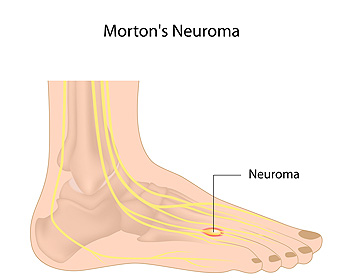 The nerve tissue between the third and fourth toes are affected when a condition known as Morton’s neuroma is present. It can cause significant pain, and some people say it feels as if there is a rock or pebble inside the ball of the foot. The most common pain consists of a stabbing or burning sensation that typically worsens over time. This condition can develop as a result from wearing shoes that are too narrow or from medical conditions like bunions, hammertoes, and flat feet. Mild relief may be found when the affected foot is elevated or massaged. It can also be beneficial to perform certain exercises to maintain and strengthen the arch of the foot. Fill a plastic bottle with ice and roll it back and forth along the bottom of the foot. (This will help with inflammation too) Another stretch can be performed while sitting down with your legs straight in front of you. Place the ball of your foot in the middle of a towel, then grab both ends of the towel and gently pull towards your shin. If you have pain in the ball of your foot, please schedule an appointment with a podiatrist who can properly diagnose and treat Morton’s neuroma.
The nerve tissue between the third and fourth toes are affected when a condition known as Morton’s neuroma is present. It can cause significant pain, and some people say it feels as if there is a rock or pebble inside the ball of the foot. The most common pain consists of a stabbing or burning sensation that typically worsens over time. This condition can develop as a result from wearing shoes that are too narrow or from medical conditions like bunions, hammertoes, and flat feet. Mild relief may be found when the affected foot is elevated or massaged. It can also be beneficial to perform certain exercises to maintain and strengthen the arch of the foot. Fill a plastic bottle with ice and roll it back and forth along the bottom of the foot. (This will help with inflammation too) Another stretch can be performed while sitting down with your legs straight in front of you. Place the ball of your foot in the middle of a towel, then grab both ends of the towel and gently pull towards your shin. If you have pain in the ball of your foot, please schedule an appointment with a podiatrist who can properly diagnose and treat Morton’s neuroma.
Morton’s neuroma is a very uncomfortable condition to live with. If you think you have Morton’s neuroma, contact Anas Khoury, DPM of North Eastern Foot & Ankle Specialists. Our doctor will attend to all of your foot care needs and answer any of your related questions.
Morton’s Neuroma
Morton's neuroma is a painful foot condition that commonly affects the areas between the second and third or third and fourth toe, although other areas of the foot are also susceptible. Morton’s neuroma is caused by an inflamed nerve in the foot that is being squeezed and aggravated by surrounding bones.
What Increases the Chances of Having Morton’s Neuroma?
- Ill-fitting high heels or shoes that add pressure to the toe or foot
- Jogging, running or any sport that involves constant impact to the foot
- Flat feet, bunions, and any other foot deformities
Morton’s neuroma is a very treatable condition. Orthotics and shoe inserts can often be used to alleviate the pain on the forefront of the feet. In more severe cases, corticosteroids can also be prescribed. In order to figure out the best treatment for your neuroma, it’s recommended to seek the care of a podiatrist who can diagnose your condition and provide different treatment options.
If you have any questions, please feel free to contact our office located in Passaic, NJ . We offer the newest diagnostic and treatment technologies for all your foot care needs.
